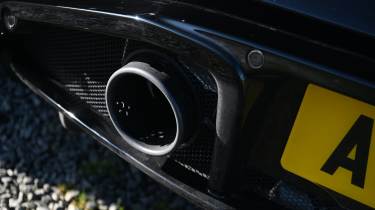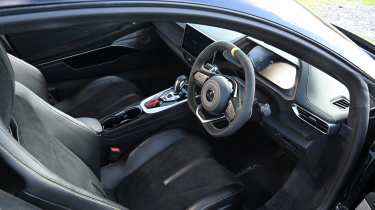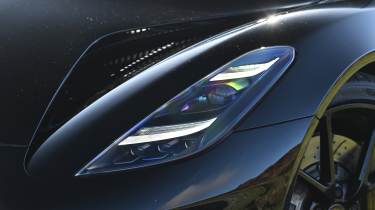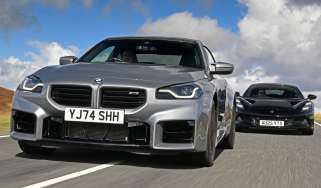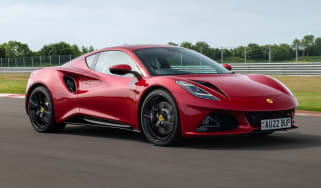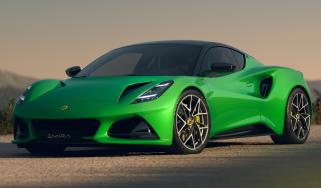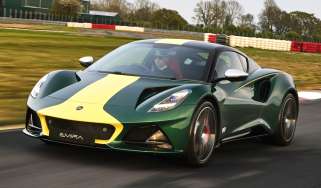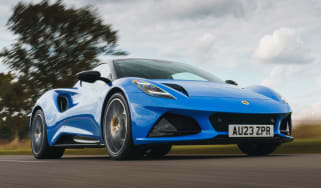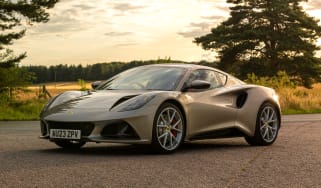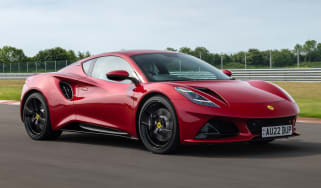Lotus Emira review
British brand’s two-seat sports car is a champion for B-road blasts

Our opinion on the Lotus Emira
A mid-engined two-seat sports car should feel special, and the Lotus Emira manages to deliver on that promise with a fun chassis that makes it enjoyable on country roads. We just wish that the powertrain choices were able to do the rest of the car justice. The 2.0-litre powered version only really delivers thrills when you’re pushing the car hard, while the gearbox can be a bit of a hindrance, too. Overall the Lotus is a fun car that’s well built and feels upmarket and sporty, but we wish it had a broader range of ability to make it a truly great driver’s car.
About the Lotus Emira
Lotus is a brand that has championed a lightweight mantra more than any other, and as a result it’s a marque that has always been favoured by buyers who value stunning driving dynamics over everything else.
The Emira is a spiritual successor to the Elise, Exige and Evora model lines, but it trades a little bit of its ancestors’ diet plan for more refinements and luxuries inside. Although we believe this has opened up the Emira’s appeal to a wider audience, it has come at the expense of ultimate thrills.
Lotus offers two engine options in the Emira. The first is a 2.0-litre turbocharged four-cylinder that’s taken from the Mercedes-AMG A 45 that comes in two power outputs, the standard model has 360bhp, while the SE has 400bhp. There’s also a development of the Toyota-sourced 3.5-litre supercharged V6 that was used in the Exige which also has 400bhp. This has a choice of six-speed automatic or manual gearboxes, while the 2.0-litre model features AMG’s eight-speed dual-clutch automatic.
Lotus Emira prices and latest deals
The Emira is largely a bespoke two-seater sports car, so new buyers can spec one up in the colour, trim and options they want. Prices start from around £80,000 for the standard car, while the SE is £10,000 on top of this. Choosing the V6 bumps the price further to £97,000, with the auto model costing £1,800 extra.
Used - available now

2024 Lotus
Emira
10,000 milesManualPetrol3.5L
Cash £56,900
2024 Lotus
Emira
3,649 milesManualPetrol3.5L
Cash £57,950It’s worth keeping an eye out for special editions, which add more kit or bespoke styling packages and can offer better value than speccing a car up individually, while the Auto Express buy a car service currently has up to £4,000 off the price of a new Emira.
Performance & driving experience
Pros |
|
Cons |
|
Sharp handling and driver involvement are musts in a Lotus, and the Emira delivers on both counts. But that’s not to say it’s perfect. The Turbo SE gets a firmer chassis than the standard Emira, and on the road, that set-up doesn’t really bring any benefits. We’d gladly trade a little outright on-track performance for more compliance on the road.
| Model | Power | 0-62mph | Top speed |
| Emira Turbo | 360bhp | 4.4 seconds | 171mph |
| Emira Turbo SE | 400bhp | 4.0 seconds | 181mph |
| Emira V6 SE | 400bhp | 4.3 seconds | 180mph |
| Emira V6 SE auto | 400bhp | 4.8 seconds | 169mph |
Performance, 0-60mph acceleration and top speed
While Lotus has turned to Toyota for its engine supply for years – indeed the V6 in the Emira is a supercharged version of the 3.5-litre unit that UK buyers could also find under the bonnet of the previous-generation Lexus RX – for this four-cylinder application, Lotus instead turned to Mercedes.
But this is no humble runabout engine; the Emira uses the same 2.0-litre turbocharged M139 unit that can be found under the bonnets of the Mercedes-AMG A 45 and the SL 43. For the standard Emira it has 360bhp, while the Turbo SE packs 400bhp and 480Nm of torque – enough, Lotus says, for a 0-62mph time of four seconds flat and a 181mph top speed.
There’s one thing we normally associate with Lotus models, and it’s that feeling of lightness spreading to every aspect of the drive. Unfortunately, in the Turbo SE, that sensation is more absent than we’d like. At low revs, the engine feels strangely lethargic, because the throttle response is quite soft and the pedal travel is long.
Mixed with an engine that struggles a little until the turbo comes on boost at around 2,000rpm, the Lotus rarely shows the effortless feeling of an Alpine A110, or even the Emira’s predecessor, the Evora, when driving at low speeds. The engine doesn’t make a particularly pleasant sound, either. A medley of gnashing, threshing and whining constantly plays right behind the driver’s ears.
There is one adjustment the driver can make which does mitigate these issues to a point, though. That’s because the Emira is improved greatly by selecting Track mode. It’s rare that we recommend the most extreme settings for a car’s powertrain on the road – and we’d still advise caution here, because Track mode eases the intervention of the traction and stability control systems – but here it also makes the throttle response significantly more lively, while a little extra exhaust tone improves the noise no end, too.
When extending the engine a little further, the turbocharger begins to let off chuffs and whistles, which make every burst of acceleration more of a giggle. Once the motor is on boost, there’s very strong performance throughout the rev range, too.
Beyond an engine that really needs to be in its naughtiest mode to feel good, the gearbox is another frustration. At low speeds, switching from drive to reverse and back again requires a couple of nudges on the lever. It’s also so slow to respond that you’re never quite sure if car and driver are in agreement on the desired direction of travel. The changes are sharper at speed, but the rev limiter is very soft, so if you mis-time a shift ,then you’ll be punished by a frustratingly long pause before it’ll select the next ratio.
There’s a fantastic soundtrack from the supercharged V6 engine, which has a properly stirring bark to it from 3,000rpm onwards. The engine also has a strong mid-range and delivers a decent thump in the back if you open it up, although it never quite manages to take your breath away with pure straight-line thrust in the same way that a six-cylinder Porsche Cayman does towards the top end of its rev range.
It’s admirably refined however, making the Emira quite a soothing cruiser, and there’s a pleasing duality between the cultured feel at lower revs and the rousing V6 howl higher up the rev range. It certainly feels good for its quoted performance figures, though the shift quality of the six-speed manual isn’t as good as it could be.
Town driving, visibility and parking
A usefully tight 10.9-metre turning circle, plus a fairly modest 4.4-metre length, mean that the Emira is actually easier than you’d expect to wiggle out of tight parking spots. The fairly broad body – and especially the wide door mirrors – mean that you’ll need to breathe in a little bit during city driving, though. The ride is firm, but doesn’t fidget and wriggle across broken surfaces as so many cars with large wheels do these days.
Country road driving and handling
Low weight is something of a virtuous circle when building a car. Less mass means better acceleration, braking and responsiveness through corners – even fuel efficiency benefits. But at 1,457kg, the Emira isn’t quite as light as some older Lotus models, and that can be felt in the car's suspension.
There’s an overlying firmness to the set-up and not quite enough travel when it hits bigger bumps, which means that the Emira never quite manages to effortlessly flow along a challenging road in a way that has become a Lotus trademark in the past couple of decades.
We’re only being critical because we hold Lotus to incredibly high standards in the chassis department; in reality, this is still one of the most engaging and best-handling two-seaters money can buy. It’s sharp and responsive through corners, with superb agility and a pointy front end making it easy to weave down a challenging piece of road.
While the steering is sharp and superbly weighted, we’d like just a little more feel to judge the car’s limits – all the more important when the mass of an engine is behind your head, always offering the potential to swing around from the rear if it’s pushed to the limits of grip. Plus on rougher surfaces, that steering can follow tramlines in the road, too.
With Touring and Sports chassis options however, and optional Michelin Cup 2 tyres, there’s scope for owners to fine-tune the Emira to a level of ability that suits their needs.
Motorway driving and long-distance comfort
Sound deadening seems to be used sparingly in the Emira, so it can be a little noisy at higher speeds. Stability is excellent, though.
The V6 model is admirably refined, making the Emira quite a soothing cruiser, and there’s a pleasing duality between the cultured feel at lower revs and the rousing V6 howl higher up the rev range. It certainly feels good for its quoted performance figures, though the shift quality of the six-speed manual isn’t as good as it could be.
"The Emira is a fantastic sports car, but I kept asking myself whether it feels like a Lotus. Sure, the Evija is a multi-million pound hypercar, but its steering is incredible and I’d love to have found a similarly communicative hydraulic set-up here. As much as it pains me to say it, the Alpine A110 feels more like a Lotus than the Emira does." - Alex Ingram, chief reviewer.
MPG & running costs
Pros |
|
Cons |
|
Considering its significant power output, we’ve always been left pleasantly surprised by the efficiency of the Mercedes-AMG M139 engine. And given that the Emira is lighter than the A 45 its motor is borrowed from, it’s not surprising that we found it to be slightly more frugal in this application than it was in a Merc. A mix of around 33mpg and a 55-litre fuel tank means that the Emira can cover just under 400 miles in everyday driving; of course, if the car’s driven more enthusiastically for extended periods – or even on track – that figure will drop significantly.
While that economy looks reasonable on paper, it’s not a match for the featherweight A110; the Alpine managed more than 35mpg over the thousands of miles we covered when we ran one on our long-term test fleet.
In comparison, the V6 car is incredibly thirsty. The manual model manages 25mpg under WLTP test conditions, while the auto version is marginally better at 27mpg.
| Model | MPG | CO2 |
| Emira Turbo | 30.8mpg | 208g/km |
| Emira Turbo SE | 30.8mpg | 208g/km |
| Emira V6 SE | 25.0mpg | 258g/km |
| Emira V6 SE auto | 27.0mpg | 258g/km |
Insurance groups
Lotus doesn’t publish insurance groups for the Emira, but you can expect to find the sports car somewhere in the group 40-50 range, alongside rivals such as the Porsche Cayman (groups 42-50) and the A110 (groups 47 and 48).
Tax
With a price tag well in excess of the £40,000 ceiling at which the luxury car tax kicks in, from years two to six, the Emira will cost £620 a year to tax.
Depreciation
Many sports-car buyers will be choosing an Emira with their heart, but those giving a second thought to their wallet might start to reconsider. All three variants are predicted to hold just over 39 per cent of their value after three years or 36,000 miles. That is certainly going to sting compared with those who choose an A110 instead; the Alpine will hold onto closer to 60 per cent of its original value over the same period.
Interior, design & technology
Pros |
|
Cons |
|
A snug cabin puts the driver in the mood for enthusiastic driving. Build quality is a world away from past Lotus models, too.
Interior and dashboard design
Lotus has struck a fantastic balance with the Emira’s cabin. It feels pared back enough to remind you of the brand’s lightweight roots, but sufficiently well finished to justify the £80,000-plus price tag.
The superb driving position is enhanced by the low windscreen base, which gives a great view of the road ahead. The seats are snug, although some shorter testers found that the curve of the seat back pushed too highly up their spine – a little more lumbar adjustment would be welcome. The starter button is hidden under a red hinged cover, adding a little fighter jet-style theatre to every start. A small toggle switch adjusts the drive-mode settings, but it’s painfully slow to respond.
Materials and build quality
The fit and finish inside the Emira is a world away from that of Lotus models of the past. Although it’s not quite as sturdy as the likes of a BMW M2 inside, it manages to strike a balance between feeling suitably expensive for a high-end sports car, and raw and racy enough for a Lotus.
Infotainment, sat-nav and stereo
Lotus has joined the modern world with the Emira’s infotainment, but luckily it hasn’t been tempted to include features such as heating controls or drive-mode selection into the screen, which both get simple physical controls.
The touchscreen for everything else is a 10.25-inch display mounted above the central air vents, and while the menus are neatly laid out, it’s a laggy, unresponsive system to use. Things can be improved by making the most of wireless Apple CarPlay and Android Auto.
"As has become typical at the posher end of the new-car market, the Emira gets a sound system from a high-end audio manufacturer. In this case, it’s from Kent-based specialist Kef. While its set-ups in the Eletre and Emeya are superb, here the sound system is very weak and not particularly crisp." - Alex Ingram, Chief reviewer.
Boot space & practicality
Pros |
|
Cons |
|
Two-seat sports cars are rarely bought for their practicality, and the Emira’s small boot, modest interior storage and a lack of load area under the bonnet mean it’s a bit tight on space.
Dimensions and size
| Dimensions comparison | |||
| Model | Lotus Emira | Alpine A110 | Porsche 718 Cayman |
| Length | 4,412mm | 4,181mm | 4,379mm |
| Width | 1,895mm | 1,798mm | 1,801mm |
| Height | 1,225mm | 1,252mm | 1,295mm |
| Wheelbase | 2,575mm | 2,420mm | 2,475mm |
| Boot space | 151 litres | 196 litres | 272 litres |
The Emira is a touch longer, wider and lower than a Porsche Cayman and Alpine A110. For reference, that’s also slightly larger, and very slightly lower, than its Evora predecessor, which measured 4,395mm, 1,848mm and 1,229mm over the same metrics.
Seats & passenger space
As well as improved interior quality, both driver and passenger in the Emira benefit from a more open-feeling cabin environment than that of the Evora – although the Evora’s +2 rear seats have been sacrificed to allow it. Instead, you’ll find two flat areas that can be used for luggage.
Storage for smaller items isn’t bad, though. There are two cup-holders, a small storage space under the central armrest, and fairly wide door bins, too. There are even three USB ports for charging devices, in addition to a neat little wireless smartphone charging slot.
Boot space
As with most mid-engined cars, practicality isn’t an Emira strong point. The rear boot section has a volume of 151 litres and a weight limit of 50kg, while its position behind the engine and above the exhaust means that it does get a little warm.
However, the boot of the A110 can also get a little toasty, and its 96-litre capacity is smaller than the Emira’s. However, unlike both the Alpine and the Porsche Cayman, the Lotus doesn’t have any under-bonnet storage. The front boot can only be opened once some clips and screws are removed, so it’s not the work of a minute. There is, however, a modest extra storage area behind the front seats.
Reliability & safety
Pros |
|
Cons |
|
The car has not been tested by Euro NCAP, but the Emira’s strong structure and good active safety features, including LED headlights and traction control, should provide some reassurance to buyers.
Lotus offers customers an optional Extended Co-Driver Pack for £1,450. This brings the likes of adaptive cruise control, rear cross traffic alert, door opening warning and high Beam
Small-volume cars like those built by Lotus don’t tend to appear in the Driver Power survey, and you won’t find the brand itself in the best manufacturer category either. But while the overused “Lots Of Trouble, Usually Serious” acronym might once have been relevant in the brand’s darker days, the simplicity of most Lotus models, and its well-proven powertrains, mean things are far better than they used to be, and that should continue with the Emira.
The Emira comes as standard with a three-year warranty. While that’s about par for the course for performance coupes, it is two years shorter than the cover Lotus provides for its electric vehicles. Lotus notes, however, that the warranty can be invalidated by competitive use, which includes timed runs such as hillclimbs as well as more obvious racing use. “Responsible use” on track days remains covered. The Emira also has a three-year road side assistance package.
Emira service intervals are scheduled every 12 months or 10,000 miles. The company offers fixed-price servicing, although it doesn’t have single-price service plans like those available elsewhere. A first-year service comes in at £430, then it’s £710 in year two, and £430 in year three, before a £1,360 service in year four (£1,290 for automatic versions), with subsequent services starting again at £430.
Buying and owning
- Best buy: Lotus Emira Turbo SE
The 2.0-litre turbocharged Mercedes engine is a better all-rounder than the Toyota V6, and offers great performance and decent efficiency.
Lotus Emira alternatives
The obvious alternatives are the Porsche 718 Cayman and Alpine A110, which both offer two-seat, mid-engined driving thrills, although both cars are at the end of their production runs and are due to be replaced by all-electric alternatives. That leaves the Emira as a car in a field of one, although we have tested the car against the BMW M2, a two-door coupe that delivers performance and comfort that betters the Emira in some ways, and all for a similar price.
Frequently Asked Questions
It’s great if you enjoy driving and are able to get out for a B-road blast without any other traffic around. It’s not quite a great all-rounder like a BMW M2, but it’s still a lot of fun and very enjoyable to drive, though.
Deals on the Emira and alternatives




